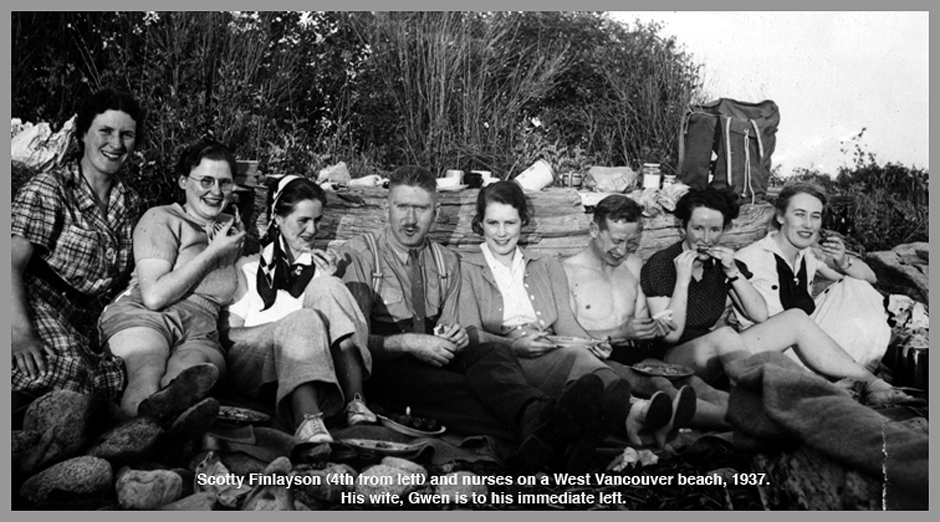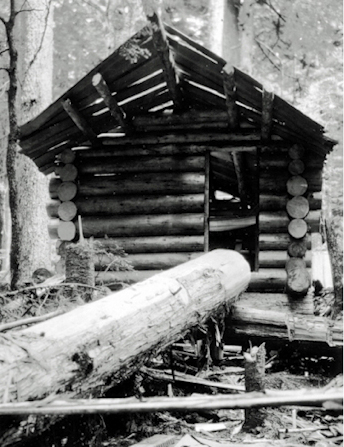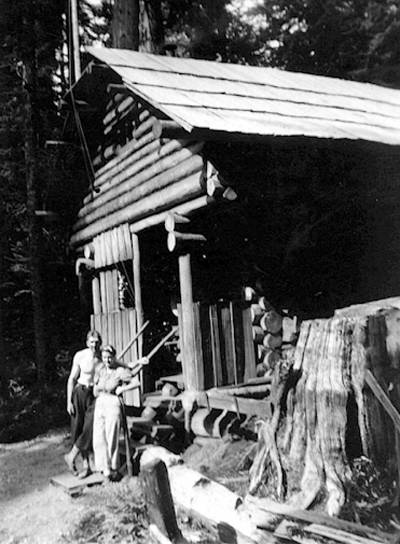
Hollyburn Memoirs - Scotty Finlayson
The following was taken from Scotty Finlayson’s memoirs that he wrote in the 1980s. Scotty died in Richmond, March 17, 1993. While working for- the Northern Pacific (1928 at age 16) I started going up Hollyburn ridge crossing on West Van ferry then West Van bus to ''22nd Street then by foot to the Ski Camp, at first stayed in the boys’ dormitory, one long bunk the length of the room. Later met some youths the same age Harry Morey, Conrad Brown, and Murdock Brown, we picked a site, cut down trees and built a log cabin, there was no supervision by the District of West Vancouver at that time.
While working for- the Northern Pacific (1928 at age 16) I started going up Hollyburn ridge crossing on West Van ferry then West Van bus to ''22nd Street then by foot to the Ski Camp, at first stayed in the boys’ dormitory, one long bunk the length of the room. Later met some youths the same age Harry Morey, Conrad Brown, and Murdock Brown, we picked a site, cut down trees and built a log cabin, there was no supervision by the District of West Vancouver at that time.
We later found that we were on private property; the land was surveyed to the 3,000 foot level anticipating that booming Vancouver would build that high. The owner in England had bought sight unseen from a map, we wrote to him and we were able to buy the property from him. I think he was glad to be rid of the property when he realized the location and taxes he had paid.
Hiking the North Shore Mountains had an interesting experience one Easter weekend; there was a Sun-rise Service on the peak of Goat Mountain, the mountain behind Grouse Mountain. We too the North Van ferry and the streetcar to the top of Lonsdale, then walked all night to the top of the mountain. There was quite a turn-out and it was a sight--the hikers strung out along the trail with their “bugs” this was the common light system for night hikes, a four pound jam pail with a coat hanger wire for a handle and an ”X” cut on one side and candle pushed through, amazingly the wind did not blow out the candle. What a sigh from Goat Mountain when the sun hit the Peak of Crown Mountain the next ridge and people joined in Easter hymns.
As the depression worsened no jobs were available at all, young men rode the freights looking for work. We had our cabin on Hollyburn and many more who still had jobs also had cabins. People were breaking into these cabins for food left in them. Some of us without jobs set up a patrol system, for 25 cents a week we would check the cabins twice a day, put up a sign that they were patrolled. It cut out the stealing and every four cabins was a dollar, and a dollar went a long way for beans and pancake flour. At one time we had six living together and doing the patrol work. There was George Lumsden, “Chuck” Rolston, and Dick Lundgren, Joe Olsen, a friend of Dick, was a member of the crew of the RCMP ship that made the East-West crossing of the Arctic, “The Northwest Passage: he stayed while on leave.
The cabin proved too small, it was only 12 feet by 16 feet, so we added another story with a four-foot overhand on each side and in front this gave us a living room downstairs and a 20 by 20 foot sleeping area up.
Then the district of West Vancouver awoke to what was at their back door and decided to set up and organize things. I was nominated by the cabin owners to represent them, Joe Leyland, the Reeve, approved the choice. This was in 1932.
 I was sworn in as a Special Constable and for $25.00 a month became the Park Ranger. Cabins no longer were built anywhere, but had to get a permit and I would allocate a site and mark trees to be used, then they paid an annual lease for cabin site and I collected for the District. I ran all the old surveys so knew where all cabins were located. During the summer I also patrolled Brothers Creek, Cypress Creek and Nelson Creek, which were used for domestic water supply for West Vancouver on the lookout for pollution such as dead animals. In winter I would open the main trail after a snowstorm with snowshoes, by Sunday night it would be packed as hard as cement and six feet wide.
I was sworn in as a Special Constable and for $25.00 a month became the Park Ranger. Cabins no longer were built anywhere, but had to get a permit and I would allocate a site and mark trees to be used, then they paid an annual lease for cabin site and I collected for the District. I ran all the old surveys so knew where all cabins were located. During the summer I also patrolled Brothers Creek, Cypress Creek and Nelson Creek, which were used for domestic water supply for West Vancouver on the lookout for pollution such as dead animals. In winter I would open the main trail after a snowstorm with snowshoes, by Sunday night it would be packed as hard as cement and six feet wide.
I moved a log cabin that was located about a half mile outside the area set aside for the regulated cabin area, numbered the logs as I took it apart and with a horse hauled the logs down to the Ski Camp and rebuilt it as the Ranger Cabin. During the week I took care of First Aid, on the weekends had volunteers from St. John’s Ambulance Brigade. Depression was at its worst, the Provincial government took over the Vancouver Ski Club clubhouse and brought a group of unemployed youths to train in forestry, a labor force for the lumber industry when conditions improved, together with an instructor and a cook. I would mark the route e for a ski run and the instructor would bring in the crew to cut down the trees, felling into the hollows, to make a ski run about two hundred feet wide. We were having a problem with “rogue” black bears, breaking into the cabins, we tried heavy shutters over the windows but then they took to tearing off the roof. I went hunting and killed off some of the rogues and then the camp cook ground the meat for hamburger and it was much appreciated. I rendered some of the fat into shortening and found it made excellent pastry; in fact my blueberry pies were quite famous.
There seemed to be much heavier snow fall at that time than we have today, eighteen to twenty feet was common, I can remember one week in which we had six feet of snow fall. Cabin owners had to tie a snow shovel up in a nearby tree with a rope and when they arrived on the weekend get down the shovel and dig down to their cabin entrance.
By 1937 I was also assisting the regular West Vancouver Police in uniform at dances at Horseshow Bay on Saturday night. At daylight I would change to hiking clothes and climb over Black Mountain and cross to Hollyburn Ridge for rent collecting from cabin owners. I would usually have a nap in the sun on top of Black Mountain before completing the trip.
November 15, 1936 I was out with another skier checking snow conditions before opening ski season. I ran one ski under a buried tree branch and spun around until the bone broke in my lower leg, a spiral break like a corkscrew.
We had not heard about hypothermia then so I lay there in the snow until my companion returned with ski camp operators and a toboggan. They hauled me down to the road end and then by Ambulance to Vancouver General Hospital. After the ski season I had a chance to join the regular West Vancouver Police force so left the Ranger job for a younger man.

(Scotty Finlayson's memoirs relate the remarkable adventures of the first ranger on Hollyburn Ridge. Scotty's stories and photo collection have come to us through his daughter, Darlene Nickull. Darlene also gave us the opportunity to convert Scotty's Hollyburn movies into a digital format, a copy of which are now in the HHS archives. This historic film, taken during the 1930's, includes panoramic views of First Lake (in colour), winter trips to the peak of Mt. Strachan, and several shots of skiers on the Romstads hill. HHS is indeed fortunate to have a copy of this rare film.)